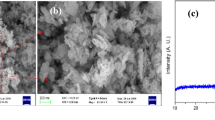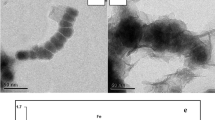Abstract
Sulfamonomethoxine (SMM) is an emerging organic pollutant that is environmentally persistent, highly toxic, and difficult to degrade, and there is an urgent need to develop efficient degradation methods. Therefore, this paper investigates the degradation of SMM using iron–copper catalyst-activated persulfate (PS). With an iron–copper catalyst amount of 1.5 g/L, initial sodium persulfate solution concentration of 2 mmol L−1, and initial solution pH = 7, the SMM removal rate reached approximately 99.7% after reaction for 2 h. When NO3− and Cl− coexisted in the system, the degradation efficiency of SMM (more than 99% at 2 h) did not change significantly. When SO42− was present in the system, the inhibition effect was insignificant (97.1% at 2 h). The presence of HCO3− and H2PO4− resulted in noticeable inhibitory effects, with SMM degradation rates of 47.4% and 76.8%, respectively. Electron paramagnetic resonance analysis showed that the radical that plays a dominant role in the degradation of SMM in this system is SO4−·, Cu(I), Cu(II), and Fe(II) activate PS to produce SO4−·, and some SO4−· is converted to ·OH with high redox potential. Therefore, it is assumed that the degradation pathway of SMM involves attack by SO4−· and ·OH, and the formation of corresponding intermediate products, which finally degrade to CO2, H2O, and other low-molecular-weight substances, thus achieving degradation.














Similar content being viewed by others
Data availability
All data generated or analyzed during this study are included in this published article (and its supplementary information files).
References
Berger K, Petersen B, Buening-Pfaue H (1986) Persistence of drugs occurrring in liquid manure in the food chain. Archiv fuer Lebensmittelhygiene (Germany, FR)
Carvalho IT, Santos L (2016) Antibiotics in the aquatic environments: a review of the European scenario. Environ Int 94:736–757
Chen X (2007) Degradation of typical organic pollutants in water by advanced oxidation based on sulfuric acid radicals. Dalian: PhD thesis, Dalian University of Technology
Duan L (2005) Study on the fate of sulfadimethoxine and its main metabolites in sandy loam soil. China Agricultural University, Beijing
Fu X, Zhao W, Du J et al (2020) Stabilization of rhodamine B by zero-valent iron nanoparticle-activated persulfate. China Water Supply Drainage 36(11):57–62
Huang Y, Lu T, Xu R et al (2020) Research progress in the treatment of antibiotics in pharmaceutical wastewater. Sci Technol Innov 5:81–82
Kamagate M, Assadi AA, Kone T et al (2018) Activation of persulfate by irradiated laterite for removal of fluoroquinolones in multi-component systems. J Hazard Mater 346:159–166
Lei Y, Chen CS, Tu YJ et al (2015) Heterogeneous degradation of organic pollutants by persulfate activated by CuO-Fe3O4: mechanism, stability, and effects of pH and bicarbonate ions. Environ Sci Technol 49(11):6838–6845
Li D, Zhang N, Yuan R et al (2021) Effect of wavelengths on photocatalytic oxidation mechanism of sulfadiazine and sulfamethoxazole in the presence of TiO2. J Environ Chem Eng 9(5):106243
Liu H (2013) reaction characteristics of sulfate radical in water treatment. Dalian Maritime University, Dalian
Lutze HV, Bircher S, Rapp I et al (2015) Degradation of chlorotriazine pesticides by sulfate radicals and the influence of organic matter. Environ Sci Technol 49(3):1673–1680
Ma Q, Zhang H, Zhang X et al (2019) Synthesis of magnetic CuO/MnFe2O4 nanocompisite and its high activity for degradation of levofloxacin by activation of persulfate. Chem Eng J 360:848–860
Mi J, Tian L, Kui H (2020) Research progress of persulfate activation methods. Ind Water Treatm 40(7):20–25
Pure Y (2019) Study on degradation of sulfadiazine by iron-copper composite oxide hollow sphere activated sodium persulfate. Xi’an Univ Arch Sci Technol. https://doi.org/10.27393/d.cnki.gxazu.2019.000016
Song H, Li Q, Ye Y et al (2021) Degradation of cephalexin by persulfate activated with magnetic loofah biochar: performance and mechanism. Sep Purif Technol 272:118971
Sun C, Zhou R, Jianan E et al (2015) Magnetic CuO@ Fe 3 O 4 nanocomposite as a highly active heterogeneous catalyst of persulfate for 2, 4-dichlorophenol degradation in aqueous solution. RSC Adv 5(70):57058–57066
Sun J, Li Q, Zhang D et al (2022) Relying on the non-radical degradation of oxytetracycline by peroxymonosulfate activated with a magnetic Cu/Fe composite: performance and mechanism. New J Chem 46(38):18251–18261
Siyuan W (2019) Study on oxidative degradation of p-chlorophenol by NaClO catalyzed by bimetallic composite catalyst. Huazhong Univ Sci Technol. https://doi.org/10.27157/d.cnki.ghzku.2019.001314
Wang Y, Zhao H, Li M et al (2014) Magnetic ordered mesoporous copper ferrite as a heterogeneous Fenton catalyst for the degradation of imidacloprid. Appl Catal B 147:534–545
Zhang D, Sun J, Li Q et al (2022) Cu-Doped magnetic loofah biochar for tetracycline degradation via peroxymonosulfate activation. New J Chem 46(36):17223–17234
Zhang X, Feng M, Qu R et al (2016) Catalytic degradation of diethyl phthalate in aqueous solution by persulfate activated with nano-scaled magnetic CuFe2O4/MWCNTs. Chem Eng J 301:1–11
Zhang Y, Wang J (2019) antibiotic residues in water environment and their ecological and health effects. J Hubei Med College 38(6):609–614
Acknowledgements
This project was supported by the National Natural Science Foundation of China (NSFC) (51809211). The Scientific Research Program Funded by Shaanxi Provincial Education Department (No.20JY045). The Natural Science Foundation of Shaanxi Province (2019JQ-745). The China Postdoctoral Science Foundation (2018M633548). And Guangdong Water Science and Technology Project(2015-06).
Funding
This project was supported by the National Natural Science Foundation of China (NSFC) (51809211). The Scientific Research Program Funded by Shaanxi Provincial Education Department (No.20JY045). The Natural Science Foundation of Shaanxi Province (2019JQ-745). The China Postdoctoral Science Foundation (2018M633548). Guangdong Water Science and Technology Project (2015-06).
Author information
Authors and Affiliations
Contributions
MW is a lecturer at the State Key Laboratory of Eco-hydraulic in Northwest Arid Region, Xi’an University of Technology, Xi’an, Shaanxi, PR China. JS is a master candidate of Environmental Science and Technology, State Key Laboratory of Eco-Hydraulics in Northwest Arid Zone, Xi’an University of Technology. HZ is a master candidate of Environmental Science and Technology, State Key Laboratory of Eco-Hydraulics in Northwest Arid Zone, Xi’an University of Technology. YZ is a PhD student of Environmental Science and Technology at the State Key Laboratory of Eco-hydraulic in Northwest Arid Region, Xi’an University of Technology, Xi’an, Shaanxi, PR China.
Corresponding author
Ethics declarations
Conflict of interest
The authors declare that they have no known competing financial interests or personal relationships that could have appeared to influence the work reported in this paper.
Ethical approval
This study and included experimental procedures were approved. All animal housing and experiments were conducted in strict accordance with the institutional windings for the care and use of laboratory animals.
Consent to participate
Written informed consent was obtained from all the participants prior to the enrollment (or for the publication) of this study (or case report).
Consent to publish
This study was published in the journal and consent was obtained from all participants.
Additional information
Editorial responsibility: Maryam Shabani.
Rights and permissions
Springer Nature or its licensor (e.g. a society or other partner) holds exclusive rights to this article under a publishing agreement with the author(s) or other rightsholder(s); author self-archiving of the accepted manuscript version of this article is solely governed by the terms of such publishing agreement and applicable law.
About this article
Cite this article
Wang, M., Sun, J., Zhai, H. et al. Degradation of sulfamonomethoxine by iron–copper catalyst-activated persulfate. Int. J. Environ. Sci. Technol. (2024). https://doi.org/10.1007/s13762-024-05517-8
Received:
Revised:
Accepted:
Published:
DOI: https://doi.org/10.1007/s13762-024-05517-8




